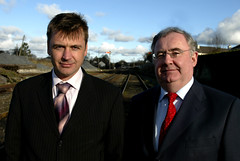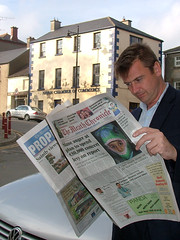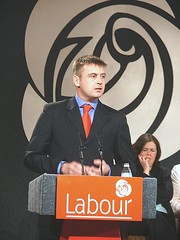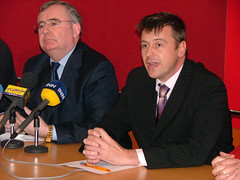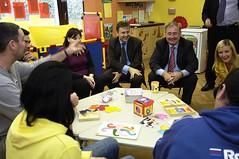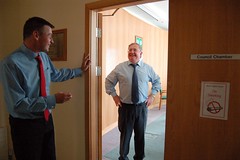Tuesday, December 01, 2009
Ireland leads the fight against AIDS in Lesotho
The Kingdom of Lesotho is one of the most unspoilt and beautiful countries in the southern hemisphere. But it’s also one of the poorest, with a shockingly low life expectancy of just 44 years. Almost one out of every four adults has HIV, the third highest rate in the world.
Irish Aid has been in the country since the early ‘70s and it remains one of our nine priority countries. The 2 million inhabitants occupy a land area roughly the size of Munster. Landlocked by South Africa, the country is largely mountainous, apart from the lowland region where the capital, Maseru, is located.
During the apartheid years many countries kept an embassy in Lesotho, preferring to monitor developments in South Africa from here rather than from Pretoria. Once apartheid ended many countries closed their embassies and moved out.
Ireland stayed. Our Ambassador to Lesotho, Paddy Fay, is now the only ambassador from a European country. Our support here has been consistent over the years. Through Irish Aid every Irish man, woman and child gives around €3 a year to Lesotho. Last week as a member of the Foreign Affairs Committee I visited Lesotho to see the Irish Aid programme in action.
Ambassador Fay and his Head of Development, Pat Curran, guided us through the Irish Aid program during our visit. Our programme is focussed on several different strands, including the fight against HIV / AIDS. The disease has permeated the entire country, reaching deep into isolated rural mountain areas. It is thought that the spread is linked to returning migrant workers from the South African mines.
Working with the Ministry of Health and the Clinton Foundation, our programme has built 7 new health clinics in these rural areas, which can often be hours away from the nearest road. Typically each clinic serves about 100 local villages, providing health cover to about 100,000 people. In each clinic we visited there was just one doctor, supported by a handful of nurses. The staff undertake HIV testing and monitoring, and proscribe and provide the Anti-Retroviral Therapies (ARTs) to patients. The clinics also provide other general health care to the local population. Two more clinics are in the pipeline, which will mean that coverage is extended to a further 200,000 people.
Because of the remoteness of the areas the recruitment and retention of staff has proved difficult in the past. Irish Aid has assisted with the recruitment of over 100 nurses and has provided a “mountain working allowance” of 10% of salary to encourage nurses to remain. The recruitment and retention problem also affects doctors. I spoke to the doctor at the Nkau clinic. Originally from Maseru, he left Lesotho to study in South Africa. He came back to practise, but many of his fellow doctors stayed in South Africa. They didn’t just stay for the money, he told me, it was also that the opportunity for professional development, for instance in radiology, cardiology, or other fields, was greater in a more developed health system. “If I stay in Lesotho then I can only ever be a GP”, he said.
The clinics can be up to two days walk away for some – too far for many ill people. Where possible these are served by outreach health workers, who travel on the dirt roads by motorbike. These bikers provide a service that would otherwise not be available for many. Last year the singer Elton John donated 120 motorbikes to these health centres, saying “We want to improve the transport system by bringing health care to millions of people living in the most rural areas and thus make a difference in their lives.”
Our aid money also supports a rural food security project run by the Catholic Relief Services. Their Head of Programs, Adam Weimer, described how he works with families affected by HIV to improve their access to fresh vegetables. Beside their homes they build “Keyhole gardens” - small waist-high beds of about 2m in diameter - which the patients can tend to with little exertion and without bending. These beds provide a plentiful supply of onions, carrots, potatoes, maize etc, thus ensuring that the patients have a healthy diet whilst undergoing ART.
The programme has worked with households to establish about 5,000 of these gardens in rural areas. The costs of the gardens are largely up front: once built the gardens can last for years. Adam pointed out that a budget cut of €50,000 would prevent him from extending the program to another 2,000 people.
Walking around the villages and the health centres it is evident that the combined approached being taken by Irish Aid and our partners is having a significant impact on the health of the local population, and that the results have been dramatic. The only loser appears to be the local coffin maker. Ambassador Fay recounts how when he first visited here, people were literally coming in the front door of the clinic and being taken out the back shortly afterwards by the local undertaker. With the success of the ART drugs that undertaker has now gone out of business. “I just wasn’t getting customers anymore”, said the undertaker. “It’s time for me to move elsewhere”.
The advent of ART has had a large impact on the how the disease is perceived. Before drugs were available there was a huge stigma associated with the disease, which meant that many people failed to seek treatment. This denial no doubt helped to spread the disease. Now, with treatment so readily available, carriers feel less stigmatised and seek tests and treatment sooner.
The fact that the Irish mission is one of the oldest, largest and most giving is not lost on the government of Lesotho. At a working lunch at the Embassy Ambassador Fay hosted the Minister for Finance, the Minister for Health and the Minister for Public Works. Their joint presence illustrates the importance that Lesotho attaches to the continuation of the Irish Aid programme.
The Minister of Health asked that we take a clear message of gratitude back to the Irish people, adding that “without Irish help thousands of people who are alive today would be dead. Thousands of children would be orphans.”
The fight against HIV / AIDS has come a long way in the last decade. Just ten years ago the impact of stigmatisation, the lack of access to drugs, and food insecurity were huge problems. Now the hopelessness has gone. Because of the Irish Aid program thousands of HIV sufferers and their children have a chance of having a healthier, longer life.
Irish Aid has been in the country since the early ‘70s and it remains one of our nine priority countries. The 2 million inhabitants occupy a land area roughly the size of Munster. Landlocked by South Africa, the country is largely mountainous, apart from the lowland region where the capital, Maseru, is located.
During the apartheid years many countries kept an embassy in Lesotho, preferring to monitor developments in South Africa from here rather than from Pretoria. Once apartheid ended many countries closed their embassies and moved out.
Ireland stayed. Our Ambassador to Lesotho, Paddy Fay, is now the only ambassador from a European country. Our support here has been consistent over the years. Through Irish Aid every Irish man, woman and child gives around €3 a year to Lesotho. Last week as a member of the Foreign Affairs Committee I visited Lesotho to see the Irish Aid programme in action.
Ambassador Fay and his Head of Development, Pat Curran, guided us through the Irish Aid program during our visit. Our programme is focussed on several different strands, including the fight against HIV / AIDS. The disease has permeated the entire country, reaching deep into isolated rural mountain areas. It is thought that the spread is linked to returning migrant workers from the South African mines.
Working with the Ministry of Health and the Clinton Foundation, our programme has built 7 new health clinics in these rural areas, which can often be hours away from the nearest road. Typically each clinic serves about 100 local villages, providing health cover to about 100,000 people. In each clinic we visited there was just one doctor, supported by a handful of nurses. The staff undertake HIV testing and monitoring, and proscribe and provide the Anti-Retroviral Therapies (ARTs) to patients. The clinics also provide other general health care to the local population. Two more clinics are in the pipeline, which will mean that coverage is extended to a further 200,000 people.
Because of the remoteness of the areas the recruitment and retention of staff has proved difficult in the past. Irish Aid has assisted with the recruitment of over 100 nurses and has provided a “mountain working allowance” of 10% of salary to encourage nurses to remain. The recruitment and retention problem also affects doctors. I spoke to the doctor at the Nkau clinic. Originally from Maseru, he left Lesotho to study in South Africa. He came back to practise, but many of his fellow doctors stayed in South Africa. They didn’t just stay for the money, he told me, it was also that the opportunity for professional development, for instance in radiology, cardiology, or other fields, was greater in a more developed health system. “If I stay in Lesotho then I can only ever be a GP”, he said.
The clinics can be up to two days walk away for some – too far for many ill people. Where possible these are served by outreach health workers, who travel on the dirt roads by motorbike. These bikers provide a service that would otherwise not be available for many. Last year the singer Elton John donated 120 motorbikes to these health centres, saying “We want to improve the transport system by bringing health care to millions of people living in the most rural areas and thus make a difference in their lives.”
Our aid money also supports a rural food security project run by the Catholic Relief Services. Their Head of Programs, Adam Weimer, described how he works with families affected by HIV to improve their access to fresh vegetables. Beside their homes they build “Keyhole gardens” - small waist-high beds of about 2m in diameter - which the patients can tend to with little exertion and without bending. These beds provide a plentiful supply of onions, carrots, potatoes, maize etc, thus ensuring that the patients have a healthy diet whilst undergoing ART.
The programme has worked with households to establish about 5,000 of these gardens in rural areas. The costs of the gardens are largely up front: once built the gardens can last for years. Adam pointed out that a budget cut of €50,000 would prevent him from extending the program to another 2,000 people.
Walking around the villages and the health centres it is evident that the combined approached being taken by Irish Aid and our partners is having a significant impact on the health of the local population, and that the results have been dramatic. The only loser appears to be the local coffin maker. Ambassador Fay recounts how when he first visited here, people were literally coming in the front door of the clinic and being taken out the back shortly afterwards by the local undertaker. With the success of the ART drugs that undertaker has now gone out of business. “I just wasn’t getting customers anymore”, said the undertaker. “It’s time for me to move elsewhere”.
The advent of ART has had a large impact on the how the disease is perceived. Before drugs were available there was a huge stigma associated with the disease, which meant that many people failed to seek treatment. This denial no doubt helped to spread the disease. Now, with treatment so readily available, carriers feel less stigmatised and seek tests and treatment sooner.
The fact that the Irish mission is one of the oldest, largest and most giving is not lost on the government of Lesotho. At a working lunch at the Embassy Ambassador Fay hosted the Minister for Finance, the Minister for Health and the Minister for Public Works. Their joint presence illustrates the importance that Lesotho attaches to the continuation of the Irish Aid programme.
The Minister of Health asked that we take a clear message of gratitude back to the Irish people, adding that “without Irish help thousands of people who are alive today would be dead. Thousands of children would be orphans.”
The fight against HIV / AIDS has come a long way in the last decade. Just ten years ago the impact of stigmatisation, the lack of access to drugs, and food insecurity were huge problems. Now the hopelessness has gone. Because of the Irish Aid program thousands of HIV sufferers and their children have a chance of having a healthier, longer life.

